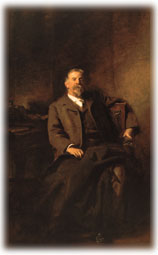![]()
Main Menu ·
Search ·
Current Issue · Contact · Archives · Centennial · Letters to the Editor · FAQs
![]()
Main Menu ·
Search ·
Current Issue · Contact · Archives · Centennial · Letters to the Editor · FAQs
Sargent and Major Sargent's portrait of Higginson, thought Henry James, "[made] the human statement with great effect." A Sargent exhibition at the Museum of Fine Arts runs from June 27 to September 26, coinciding with Sargent in the Studio, an exhibit at the Fogg Art Museum from June 17 through September 5.HARVARD PORTRAIT COLLECTION, PRESIDENT AND FELLOWS OF HARVARD COLLEGE, PRESENTED FOR THE USE OF HARVARD COLLEGE BY HENRY PICKERING, 1823. PHOTOGRAPH BY DAVID MATHEWS |
For years, every freshman en route to meals passed the brown and solemn portrait of Boston financier Henry Lee Higginson, class of 1855, that hung in the oak-paneled Great Hall of the Harvard Union. Although the Union is now the Barker Center for the Humanities, Higginson still presides--a familiar, if enigmatic, presence. He was the donor of the Union; the painting, by the famous expatriate portraitist John Singer Sargent, was completed in 1903, shortly after the dedication of the building. The plaque next to the portrait recounts Higginson's hopes that the Union would promote "democracy and comradeship" among undergraduates. But it is the image, rather than Higginson's words, that lends an aura of humanity and history to the space. In its own day Higginson was known as "the most important picture painted by Sargent in America." Its reputation has not faltered: it will be prominently featured in John Singer Sargent, the landmark exhibition opening in June at the Museum of Fine Arts, Boston.
What Henry James, Litt.D. '11, called Sargent's "knock-down insolence of talent" attracted a clientele that included the leading lights of Edwardian England and America's Gilded Age, both socialites and key figures of international politics, letters, and commerce. In 1903, Sargent had already painted President Theodore Roosevelt, A.B. 1880, LL.D. '02, Secretary of State John Hay, LL.D. '02, and Alexander Cassatt, president of the Pennsylvania Railroad, before beginning his portrait of Higginson, the leading Boston philanthropist of the era.
Higginson was a complex character, a man whose Brahmin rectitude and orthodox philanthropies covered poignant disappointments. He had, for example, aspired to be a concert pianist--an impractically romantic profession for a proper Bostonian--but inept medical treatment for a hand injury destroyed those hopes. (Perhaps in compensation, he founded the Boston Symphony Orchestra in 1881 and for years was its sole underwriter.) His youthful writings express private ambitions for his Harvard career, but ill health forced him to leave the College after only a few months. He served proudly in the Union army during the Civil War (and ever after preferred to be addressed as Major Higginson), but the only action he saw was an inconsequential skirmish in Virginia in which he was gravely wounded. Yet his loyalty to Harvard and to his country never wavered. In addition to financing the Union, he used his ample earnings from the family brokerage firm to endow a professorship, to secure the properties that became the sites of Harvard's medical and business schools, and to purchase the land for Soldiers Field in memory of friends whose contribution to the war effort had been greater than his.
A patron of the visual arts, Higginson later donated much of his collection to the Museum of Fine Arts. However, he did not seek out Sargent for the portrait--the commission may well have been initiated by a group of undergraduates, and was paid for by student subscription. The architect Charles McKim, A.M. (hon.) 1890, who designed the Union, may have introduced painter and philanthropist. The sittings began in March 1903, in a borrowed studio on Newbury Street.
Sargent posed Higginson in a massive armchair, his arm thrown over its back. The sitter appears relaxed yet dignified, a man of great physical strength despite his 70 years. His surroundings are somber and austere, an old-fashioned, masculine atmosphere befitting, according to one admirer, "[an] American imbued with high ideals." The table piled with books suggests Higginson's stature as a man of affairs. Although the portrait was destined for the Union, it contains no reference to his recent philanthropies. Rather, it recalls his participation in the Civil War, 40 years earlier. The saber scar on his right cheek is highlighted in proud remembrance of his military career; across his lap is draped his cavalry officer's cloak. The portrait is a tribute to honorable old age, and to a life of public service.
Shortly after the portrait was completed, Harvard loaned it to a Sargent exhibition at the Museum of Fine Arts, where it was deemed the noblest work on view. Although curmudgeonly Henry Adams, A.B. 1858, professed doubts as to its "sincerity of truth," Richard Watson Gilder, A.M. (hon.) 1890, the editor of Scribner's Monthly, proclaimed it "a ripper,...with all Sargent's best characterization and brilliancy." For Henry James, not only did the portrait "interfuse a group of public acts with the personality...of the actor," it also provided "a magic carpet," a reminder both of Harvard's great intellectual tradition and of its distinguished past.
Carol Troyen
Main Menu ·
Search · Current Issue · Contact · Archives · Centennial · Letters to the Editor · FAQs
![]()